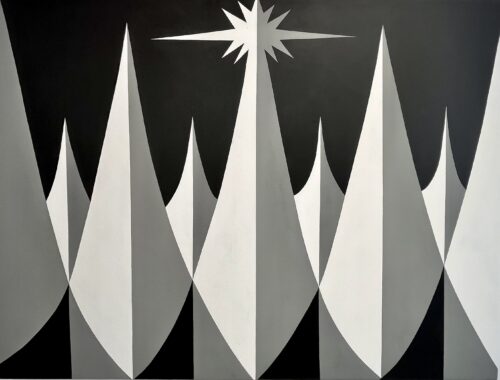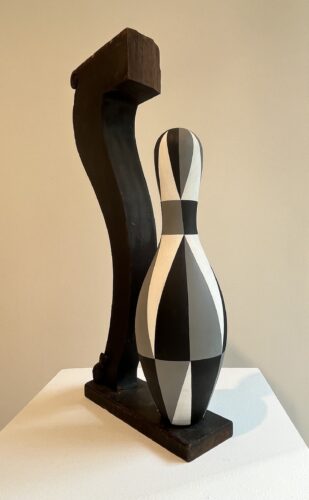Brooklyn artist Ryan Bock dislikes labels; though his work suggests so many, but bows to so few.
Ode to Duchamp; a Liar, Bock’s latest solo show at Manhattan’s Ki Smith Gallery, is typical of his latest work. One room is dominated by his interactive masterwork, a giant chess set made of cast-off piano parts. In the other room, a pair of geometrically painted bowling pins are accompanied by aged wood frameworks. The walls are bedighted with two regimented, symmetric paintings that suggest troops arrayed for battle. Everything is in black, white and gray.
Like much of his oeuvre, the work in Ode is highly organized and disciplined. To invoke a few of those hated labels; there are shades of cubism, constructivism, suprematism and futurism. But by surrendering his art to limitations, restraint and systemization, he may really be rejecting those things, satirically mocking modern obsessions with systems of gain and control and capitulation to mechanization and technology. In setting limits, Bock liberates himself, and his viewers, from them.
“Don’t call it anything,” Bock insisted during an interview with Art511 the other day. “This body of work is more inspired by Dadaist theory than anything else,” he added. Now there’s a counterintuitive thought, for Ode is neither random nor absurd. But while it may not appear as overtly Dadaist work, the installation taken as a whole certainly hues to Dadaist theory.
The chess set is a perfect example of this. It is precisely organized, the pieces were created in appropriate proportion to one another and they have been arrayed on black and white squares in their proper places, according to the rules. But the rule-following is disrupted violently by closer examination of the pieces, which are constructed from the sacrificed remains of pianos that were once themselves participants in the creation of art.
So creating art that is organized and symmetric from pieces salvaged from a dumpster has latent Dada trappings in the same way Romanian avant-garde poet Tristan Tzara’s 1918 “Manifeste Dada” was a non-manifesto. “I write a manifesto and I want nothing, yet I say certain things, and in principle I am against manifestos, as I am also against principles,” he wrote. Dada, of course, was an anti-movement and, so it follows, anti-Dada.
While chess is a game centered on planning and strategy, its greatest players succeed via counterintuitive play. That’s why great chess masters are able to beat computers and their slavish adherence to establish tenets of strategy. And let’s not forget that Marcel Duchamp, the reluctant Dadaist whose name Bock borrowed for this show, was obsessed with the game, made his own chess set, and ostensibly retired from his art practice at its height in the 1920s to pursue chess professionally. “I am still a victim of chess. It has all the beauty of art—and much more,” he was quoted as saying.
One of the two paintings in the installation is a stylized representation of chess pieces that exploits cunning geometry to evoke consideration of dark and light, good and evil, big and small, power and weakness. The second one is likewise militaristic, with dark undercurrents of domination, cultish conformity, Nazism and the Klan.
The bowling pins are interesting in their employ of lined geometry – stripes on one, triangles on the other – on a medium that is anything but angular, again marrying diverse elements into a serviceable whole. Add to that the incongruity of the aged wood accoutrement and you have a trifecta of nonconformity.
The bowling pins, and the entirety of Bock’s oeuvre in fact, seem to owe their stylistic lineage not so much to the Dada movement, but to another 1920s school of design and theory, Bauhaus, one label that Bock does embrace. Relying as he does on bold, simple, minimalist design and non-color, Bock sometimes goes by the handle Bockhaus, as he does on Instagram.
Composing art in black, white and gray is hardly the exclusive province of Bauhaus artists. Picasso’s Guernica is surely the best known such work and Franz Kline famously eschewed color in his personal form of abstract expressionism. But Bock’s work, like that of his Bauhaus forebearers, succeeds not because of its colorlessness, but in spite of it.
There’s a quote in a recent story in another publication in which Bock says he doesn’t take himself too seriously, but this seems at odds with the person and his work. Sometimes, he said, his seriousness is lost amid other traits, like sarcasm and skepticism that borders on cynicism.
“I do take myself seriously, but I have trouble participating in things without making fun of them,” he said in a statement that could easily have been uttered by some nascent Dadaist at Cabaret Voltaire, circa 1916.
“I’m probably a satirist as much as anything else; that is, I really don’t follow. I don’t make NFTs. I don’t do what everyone else is doing. I don’t succumb. A lot of what’s happening today has nothing to do with creativity. Online, you’re rewarded for doing what everyone else is doing. There’s a social conditioning that rewards doing the same thing, but it’s sold as individuality. If you see me doing what everyone else is doing, it’s obviously satire, it’s tongue in cheek,” he said.
While his demeanor can come off as dismissive, even cynical, his attitude is grounded in the understanding that committing to art as your life’s work is hard, much harder than many believe.
“To make art is very human. It’s healthy and good for the psyche of someone to create something. But when you try to turn it into a career it changes everything. The art world is now completely oversaturated with everyone trying to have a career and to immediately monetize something that is human and normal to do,” he said.
Bock’s experience during the pandemic demonstrates exactly how confusing, frightening and discouraging an artistic existence can be.
“I was having a really hard time with art in general in 2021, 2022. I had been working alone in my studio during the pandemic and I was not really sure if what I was doing was actually meaningful. I doubted not just myself, but art as a real vehicle for creating change in people’s lives in a real way. I was in a bad place, but I had been working my way out of that. Then I just allowed myself to get led out of it through intuition. It seems like I always get led in the right direction eventually, but you can’t force it,” he said.
Having emerged from this pandemic-induced malaise, Bock found himself reinvigorated, ready to march forward with his artistic practice, which to him is as much a struggle as it is a calling.
“This shit is war. I am so serious about this. It’s the only constant in my life and I would give up anything for it, and I have. I’ve given up a lot of the life stuff I see normal people pursuing. I just don’t do that,” he said.
Ode to Duchamp; a Liar runs through Aug 6 at Ki Smith Gallery, 170 Forsyth Street, New York. Open Wednesday-Sunday, 11am – 7:00pm. The show concludes Aug. 6, with an artist talk by Bock and chess games.





